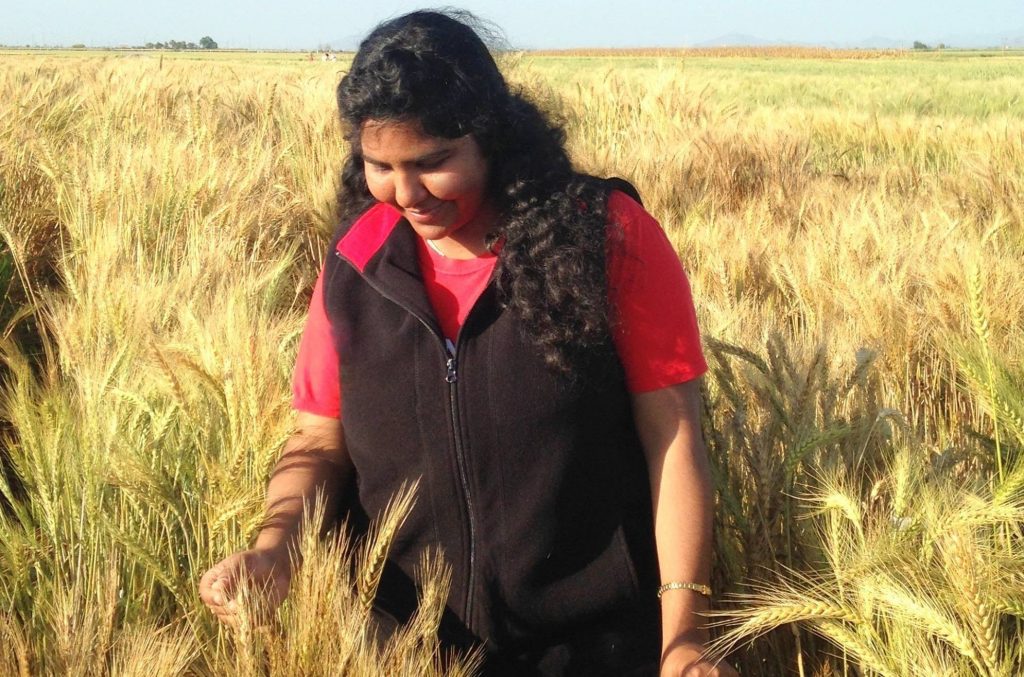August 31, 2018
 A recipient of Monsanto’s Beachell-Borlaug International Scholars Program Award, Juliana completed a Ph.D. in Plant Breeding and Genetics at Cornell University in 2016. Her work at CIMMYT seeks to identify the genetic bases of key traits in CIMMYT wheat germplasm and to assess high-throughput genotyping and phenotyping to increase the rate of genetic gain for yield in the center’s bread wheat breeding. In this work, she partners with the Cornell-led Delivering Genetic Gain in Wheat (DGGW) project and Jesse Poland of the United States Department of Agriculture (USDA) Agricultural Research Service (ARS) and Kansas State University. Her research also forms part of USAID’s Feed the Future projects.
A recipient of Monsanto’s Beachell-Borlaug International Scholars Program Award, Juliana completed a Ph.D. in Plant Breeding and Genetics at Cornell University in 2016. Her work at CIMMYT seeks to identify the genetic bases of key traits in CIMMYT wheat germplasm and to assess high-throughput genotyping and phenotyping to increase the rate of genetic gain for yield in the center’s bread wheat breeding. In this work, she partners with the Cornell-led Delivering Genetic Gain in Wheat (DGGW) project and Jesse Poland of the United States Department of Agriculture (USDA) Agricultural Research Service (ARS) and Kansas State University. Her research also forms part of USAID’s Feed the Future projects.
After 13 years of research, an international team of more than 200 scientists recently cracked the full genome of bread wheat. Considering that wheat has five times more DNA than humans, this is a significant scientific breakthrough. The complete sequencing provides researchers with a map for the location of more than 100,000 genes which, experts say, will help accelerate the development of new wheat varieties.
Philomin Juliana, a Post-Doctoral Fellow in wheat breeding at the International Maize and Wheat Improvement Center (CIMMYT) talks about the relevance of the new map for the center, whose genetics figures in the pedigrees of wheat varieties grown on more than 100 million hectares worldwide.
Are you already using this resource, and how?
We have anchored the genotyping-by-sequencing marker data for about 46,000 lines from CIMMYT’s first-year wheat yield trials (2013-2018) to the new, International Wheat Genome Sequencing Consortium (IWGSC) reference sequence (RefSeq v1.0) assembly of the bread wheat genome, with an overall alignment rate of 64%. This has provided valuable information on the location of key genome regions associated with grain yield, disease resistance, agronomic traits and quality in CIMMYT’s wheat germplasm, identified from genome-wide association mapping studies.
We have also used the new reference sequence to understand the impact of marker densities and genomic coverage on the genomic predictability of traits and have gained a better understanding of the contributions of diverse chromosome regions (distal, proximal, and interstitial) towards different phenotypes.
How will use of the new wheat reference sequence help CIMMYT and partners to develop improved wheat for traits of interest?
There are so many ways we can use this new tool! It provides valuable insights into trait genetics and genomics in bread wheat and will help us to more quickly identify candidate genes associated with traits of interest and to clone those genes. We will also be able to design molecular breeding strategies and precisely select and introgress target regions of the genome.
More generally, the reference sequence already has a range of markers — among them, simple sequence repeats (SSR), diversity array technologies (DArT) markers, and single nucleotide polymorphisms (SNPs) — anchored to it, which will facilitate comparisons between mapping studies and the quick development and validation of useful new markers.
It will also help to apply tools like gene-editing or targeted genetic modification to obtain desired phenotypes and will allow us to better characterize the genetic diversity in CIMMYT’s wheat, to identify useful genes in key CIMMYT parent lines and rapidly introgress them into breeding lines.
With the annotated whole genome information, breeders can design crosses focused directly on desired combinations of genomic regions or predict the outcome of crosses involving gene combinations.
It will definitely speed varietal testing in partner countries through quick and accurate molecular screens for the presence of desired genes, instead of having to perform multiple generations of field testing.
Finally, it will help us to detect molecular-level differences between CIMMYT varieties released in different countries.
Which traits are being targeted by CIMMYT and partners?
We are using the new reference sequence to understand better the molecular bases of grain yield, heat and drought tolerance, rust resistance, flowering time, maturity, plant height, grain and flour protein, and various other quality traits.